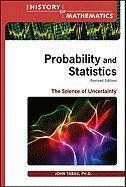

Most ebook files are in PDF format, so you can easily read them using various software such as Foxit Reader or directly on the Google Chrome browser.
Some ebook files are released by publishers in other formats such as .awz, .mobi, .epub, .fb2, etc. You may need to install specific software to read these formats on mobile/PC, such as Calibre.
Please read the tutorial at this link: https://ebookbell.com/faq
We offer FREE conversion to the popular formats you request; however, this may take some time. Therefore, right after payment, please email us, and we will try to provide the service as quickly as possible.
For some exceptional file formats or broken links (if any), please refrain from opening any disputes. Instead, email us first, and we will try to assist within a maximum of 6 hours.
EbookBell Team

4.1
70 reviews
ISBN 10: 0816062315
ISBN 13: 9780816062317
Author: John Tabak
Probability deals with measuring the likelihood of a particular outcome or event. Statistics is the collection, tabulation, and systematic classification of data, especially for use in predicting probable future trends. Crude ideas of probability and statistics likely evolved with the earliest humans, helping them decide where to go in search of food, shelter, and safety. Today's theories and methods of probability and statistics enable people to collect and analyze information relating to more complex situations than in the past, such as the prevalence or incidence of diseases among a group of people, and to make decisions calculated to result in a certain outcome.
1. The Origins of Probability
Games of Chance in Ancient Civilizations
Early Mathematical Thinking About Randomness
The Problem of Fair Division
The Birth of Probability Theory in the 17th Century
2. Pascal, Fermat, and the Foundations
Correspondence on Games of Chance
Expected Value and Mathematical Expectation
The Legacy of Pascal’s Triangle
From Gambling to Science
3. Jakob Bernoulli and the Law of Large Numbers
Ars Conjectandi
The Concept of Probability as a Limit
Early Applications and Interpretations
4. De Moivre, Bayes, and Laplace
De Moivre’s Doctrine of Chances
Bayes’ Theorem and Conditional Probability
Laplace and the Deterministic Universe
The Analytical Theory of Probability
5. The Rise of Statistics
From Probability to Data
The Birth of Demography and Vital Statistics
Quetelet and the “Average Man”
The Normal Distribution and the Bell Curve
6. Karl Pearson and the Biometrics Movement
Correlation, Regression, and the Method of Moments
Statistical Thinking in Biology and Medicine
Pearson’s Legacy and Controversies
7. The Revolution of Fisher, Neyman, and Pearson
R. A. Fisher and the Logic of Statistical Inference
Hypothesis Testing and Significance
Neyman–Pearson Framework and Confidence Intervals
8. Probability in the Twentieth Century
Measure Theory and Kolmogorov’s Axioms
Random Variables and Stochastic Processes
The Development of Mathematical Statistics
Probability in Physics and Finance
9. Modern Applications of Probability and Statistics
Simulation and Randomized Algorithms
Risk, Uncertainty, and Decision Theory
Statistical Modeling in Science and Society
10. Reflections on Uncertainty
Philosophical Interpretations of Probability
The Limits of Prediction
Probability and the Future of Data Science
introduction to probability and statistics for engineers and scientists
khan academy probability and statistics
probability and statistics book
applied probability and statistics for engineers
probability and statistics math
define probability and statistics
Tags: John Tabak, Probability, Statistics